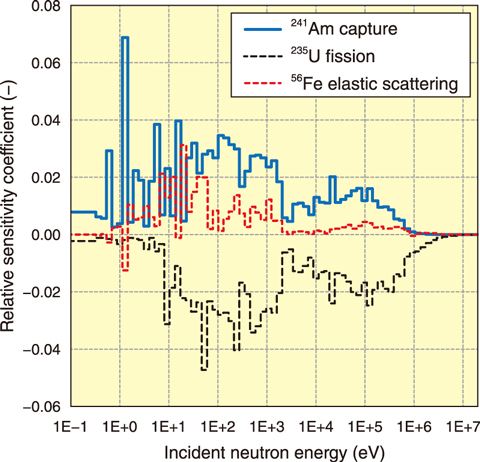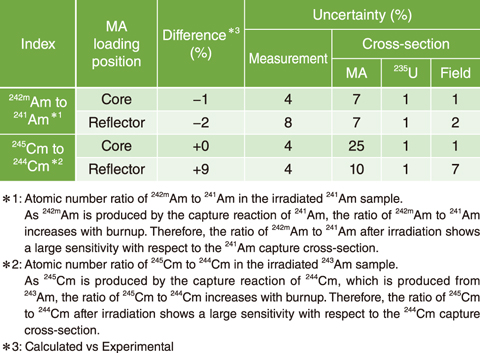
Fig.7-8 Major burnup sensitivity coefficients of the atomic number ratio of 242mAm to 241Am in the irradiated 241Am sample at the reflector position
Table 7-1 Uncertainty analysis of the atomic number ratios in the irradiated MA samples

Aiming to reduce the amount and toxicity of radioactive waste, irradiation tests of minor actinide (MA) samples, including americium and curium, were conducted using the MK-II core of the fast experimental reactor “Joyo” from 1994 to 1999. These tests intended to evaluate and improve the MA nuclear data, or incidental neutron cross-sectional data (hereafter, cross-section).
As the MA samples are minutes and their amount is a few hundred milligrams, the precise evaluation of the local neutron fluence of the MA sample is critical for the calculations of the irradiation tests. However, precisely estimating the local neutron flux via entire core calculations is difficult. The time fluctuation of the local neutron flux should be precisely estimated during long-term irradiation. Therefore, the materials having well-qualified cross-sectional data, e.g., 235U, are usually loaded as a dosimeter in the same position as the MA samples to measure the neutron fluence.
When utilizing these measured data in irradiation tests, it is essential to quantify the uncertainty to judge the applicability for the validation and improvement of the MA cross-section data. The burnup sensitivity coefficients must be calculated with respect to the cross-sections (hereafter, sensitivity). Therefore, a formula, applicable when the dosimeter is considered, was derived.
The resulting major sensitivities of the atomic number ratio of 242mAm to 241Am are presented as “Index 242mAm to 241Am” in Fig.7-8 in the reflector position. A positive large sensitivity with respect to the 241Am capture cross-section was seen. In addition, negative sensitivity with respect to the 235U fission cross-section, which is due to the dosimeter utilization, was observed, as the increase of the 235U fission cross-section causes a decrease of calculation value by means of the neutron fluence. Furthermore, a high sensitivity with respect to the cross-section of 56Fe was observed, which is a main nuclide composing the structural material.
The uncertainty analysis of two types of atomic number ratios are summarized in Table 7-1, where the cross-section-induced uncertainty was obtained by multiplying the sensitivity by the uncertainty of the cross-section. The results of Indices 242mAm to 241Am and 245Cm to 244Cm in the core position were very useful because the discrepancies between the measured and calculated values were negligible and the uncertainties of measurements and cross-section of other than MA are enough small. On the contrary, the Index 242mAm to 241Am in the reflector position showed high uncertainty and equals to that of MA cross-section. Furthermore, the Index 245Cm to 244Cm in the reflector position showed an over-estimation of the calculation value compared with the measured one. Despite low measurement uncertainty, the uncertainty of the irradiation field is quite large as well as that of the MA cross-section uncertainty. This indicates the necessity to confirm the consistency with other reactor physics data sensitive to 56Fe in terms of cross-section improvements.
Subsequently, application of the cross-section adjustment technique indicated that the main cause of the discrepancy is due to the biases of the 244Cm capture cross-section. Furthermore, biases of the 56Fe and 235U cross-sections also contribute to the discrepancy. The derived formula of sensitivity thus plays an important role on the improvement of the MA cross-section data.
This study was carried out under the contract with University of Fukui for research commissioned by the Ministry of Education, Culture, Sports, Science and Technology (MEXT), Japan to University of Fukui.